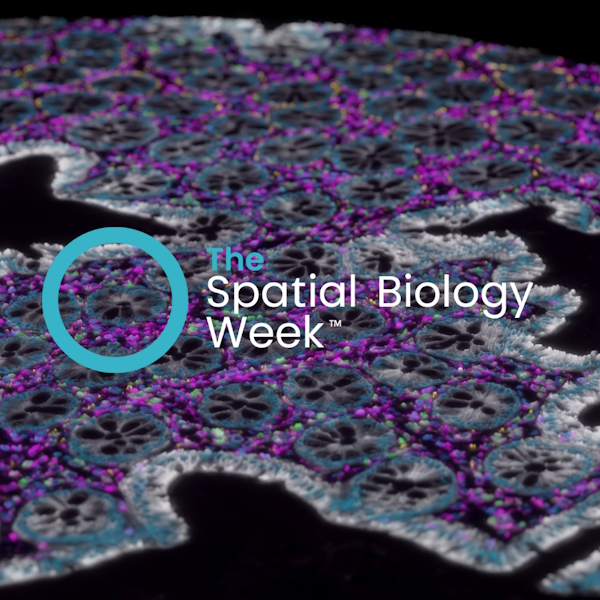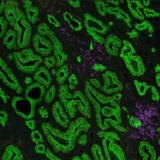Spatial Biology Education
Exploring new horizons in scientific advancement: key highlights from The Spatial Biology Week™ 2023
Posted on:

In the world of scientific research, progress is relentless and ever-evolving. New tools, techniques, and paradigms emerge regularly, pushing the boundaries of our understanding. Spatial biology is currently revolutionizing how we explore cellular and molecular landscapes. From hypothesis generation to drug discovery, The Spatial Biology Week™ 2023, taking place virtually October 2-6, 2023, was a pivotal event that illuminated the promising future of this field.
Session 1: Dissecting tissue and diseases: multimodal approaches for spatial analysis
The five-day meeting’s opening session focused on the immense potential of combining the power of spatial omics with other cutting-edge technologies. Cells are part of a dynamic network where interactions between them and their environment play a crucial role in health and disease. Researchers are increasingly turning to a multimodal approach to gain a deeper understanding of this intricate web of interactions. This approach integrates multiple technologies, from single-cell analysis to spatial multiomics and multimodal imaging, to create a more comprehensive view of biological systems. Here are some key learnings from the session:
- Multimodal approaches can support the understanding of the complexity of highly heterogeneous cancers, such as ovarian cancer and glioblastoma.
- Multimodal approaches can validate the expression of secreted proteins, study challenging markers, validate functional markers, or further characterize those markers.
- The limitation of tiny biopsies analysis can be overcome with the identification and profiling of spatially distinct areas of interest in glioblastomas.
- Quantitative assessments can be performed using spatial biology techniques on pathological samples from patients with infectious diseases.
- The combination of omics approaches can complement each other for cell identification, cell subtypes, and the identification of functional states.
Watch session 1 on demand here.
Session 2: Navigating brain architecture with spatial cell profiling
The human brain, an enormously complex organ, has captivated the imagination of scientists and researchers for centuries. Its complexity lies in its physical structure and the incredible diversity of cell types and molecular processes that govern its function. The Spatial Biology Week™ 2023’s second session unveiled the extraordinary potential of the field in shedding light on the brain’s inner workings. Learn how spatial biology supports neuroscientists in the validation and discovery of cellular pathways of brain tumors and diseases by:
- Implementing single-cell analysis to study brain diseases.
- Analyzing the blood-brain barrier to understand how drugs can be delivered to the brain.
- Revealing underlying mechanisms of nerve functions in cancer therapeutics and cancer toxicity.
- Identifying conserved cellular mechanisms and immune cell infiltration in recurrent meningiomas.
Watch session 2 on demand here.
Session 3: Spatial biomarkers for translational research
The search for effective biomarkers has taken center stage in the quest for precision medicine and improved patient care. While traditional bulk analyses have made significant contributions, they have also faced limitations in capturing the full complexity of diseases and patient variability. Spatial biology techniques have emerged as powerful tools to overcome these challenges. The third session spotlighted how these techniques are revolutionizing biomarker development and starting a new era of personalized medicine. Watch session 3 on demand to discover:
- How in situ complementomics approaches allow studying the role of complement proteins in kidney diseases.
- How to support the initial phase of clinical trials by enabling the implementation of spatial biology records.
- How the combination of morphological data and high-dimensional, single-cell image features are needed to identify relevant biomarkers in iPSC-derived neurons.
- How a multimodal approach is used to study pancreatic cystic neoplasia and to monitor the therapeutic response of pancreatic ductal adenocarcinoma.
- How a deep analysis of the chordoma immune landscape is needed.
Session 4: From pixels to biological insights: the key role of image analysis
In the era of spatial biology, where advanced techniques can detect numerous biomarkers within tissues, the generated images are filled with intricate details. However, extracting meaningful data from the images is a complex task. This complexity gives rise to the need for sophisticated image analysis techniques. Session 4 of The Spatial Biology Week™ 2023 investigated the vital role of image analysis in extracting quantitative data from hyperplex images, allowing researchers to uncover cellular interactions and dependencies crucial for basic and translational research. Access session 4 here on demand to:
- Learn how specific image analysis approaches are needed to study difficult tissues, such as cardiac and neuronal tissues.
- See how MCMIRO, a dedicated pipeline for assessing single-cell expression patterns is needed to classify tumor buds.
- Discover how HORIZON™ simplifies navigation and analysis of COMET™-generated images.
- Explore how HALO® and HALO AI platform can be used to analyze images of high-plex immuno-oncology panels.
- See how the Visiopharm® workflow supports the image analysis of hyperplex stainings.
Session 5: Success stories from technology adoption to data analysis in spatial biology
In session 5, attendees had the opportunity to explore the transformative power of spatial biology. From basic research laboratories to translational research groups, this session showcased success stories emerging from Lunaphore’s Access Lab projects, illuminating their journey in swiftly embracing spatial biology and seamlessly integrating customized workflows in fields such as immunology, immuno-oncology, and beyond. These success stories inspire researchers to navigate the challenging terrain of technology adoption and data analysis in this exciting field. As spatial biology continues to gain prominence in life sciences, these stories illustrate the tangible benefits it brings to basic and translational research, offering hope for a deeper understanding of complex biological phenomena and their applications in diverse scientific domains. Have a look at the key learnings from the session:
- Markers of inflammation could be used as targets of prostate cancer pathogenesis.
- The TME of pilocytic astrocytomas, the most common pediatric cancers, is unique and needs a deeper investigation.
- Insights from the TME composition of lymphoma can be used as tools to predict response to a specific therapy.
Watch session 5 on demand here.
A glimpse into the future
Spatial Biology Week™ 2023 was a monumental event showcasing spatial biology’s remarkable progress and potential. For five days, world-class experts from various research areas came together to explore the frontiers of this emerging field through cutting-edge research presentations, interactive workshops, and insightful discussions. From the way we generate hypotheses to how we integrate multiomics data, spatial biology is transforming the scientific landscape. It’s advancing drug discovery, offering hope to patients, and ultimately propelling scientific research to new heights. As we reflect on the findings and discussions of Spatial Biology Week 2023, one thing is clear: the future of spatial biology is incredibly bright. With each breakthrough and innovation, we inch closer to a world where diseases are better understood, treatments are more effective, and the mysteries of life’s spatial intricacies are unlocked. As scientists continue to push the boundaries of spatial biology, we can look forward to a future filled with groundbreaking discoveries and improved healthcare outcomes.

